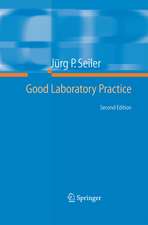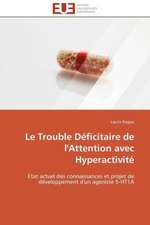Stem Cell-Derived Models in Toxicology: Methods in Pharmacology and Toxicology
Editat de Mike Clements, Liz Roquemoreen Limba Engleză Hardback – 26 noi 2016
Authoritative and cutting-edge, Stem Cell-Derived Models in Toxicology serves as a vital resource for researchers aiming to improve risk assessment in drug discovery and design.
| Toate formatele și edițiile | Preț | Express |
|---|---|---|
| Paperback (1) | 906.79 lei 6-8 săpt. | |
| Springer – 27 iun 2018 | 906.79 lei 6-8 săpt. | |
| Hardback (1) | 732.36 lei 6-8 săpt. | |
| Springer – 26 noi 2016 | 732.36 lei 6-8 săpt. |
Din seria Methods in Pharmacology and Toxicology
- 5%
 Preț: 1114.91 lei
Preț: 1114.91 lei - 5%
 Preț: 1120.40 lei
Preț: 1120.40 lei - 5%
 Preț: 1310.03 lei
Preț: 1310.03 lei - 5%
 Preț: 709.10 lei
Preț: 709.10 lei - 5%
 Preț: 1049.82 lei
Preț: 1049.82 lei - 5%
 Preț: 1058.25 lei
Preț: 1058.25 lei - 5%
 Preț: 1114.91 lei
Preț: 1114.91 lei - 5%
 Preț: 1106.69 lei
Preț: 1106.69 lei - 5%
 Preț: 1631.16 lei
Preț: 1631.16 lei - 5%
 Preț: 1042.29 lei
Preț: 1042.29 lei - 5%
 Preț: 1042.69 lei
Preț: 1042.69 lei - 5%
 Preț: 1632.41 lei
Preț: 1632.41 lei - 5%
 Preț: 1120.55 lei
Preț: 1120.55 lei - 5%
 Preț: 1362.85 lei
Preț: 1362.85 lei - 5%
 Preț: 704.74 lei
Preț: 704.74 lei - 5%
 Preț: 1010.04 lei
Preț: 1010.04 lei - 5%
 Preț: 859.82 lei
Preț: 859.82 lei - 5%
 Preț: 1133.18 lei
Preț: 1133.18 lei - 5%
 Preț: 728.52 lei
Preț: 728.52 lei - 5%
 Preț: 708.41 lei
Preț: 708.41 lei - 5%
 Preț: 731.64 lei
Preț: 731.64 lei - 5%
 Preț: 1106.69 lei
Preț: 1106.69 lei - 5%
 Preț: 735.46 lei
Preț: 735.46 lei - 5%
 Preț: 722.48 lei
Preț: 722.48 lei - 5%
 Preț: 1306.92 lei
Preț: 1306.92 lei - 5%
 Preț: 1123.33 lei
Preț: 1123.33 lei - 5%
 Preț: 735.83 lei
Preț: 735.83 lei - 5%
 Preț: 1109.08 lei
Preț: 1109.08 lei - 5%
 Preț: 727.44 lei
Preț: 727.44 lei - 5%
 Preț: 724.50 lei
Preț: 724.50 lei - 5%
 Preț: 1116.94 lei
Preț: 1116.94 lei - 5%
 Preț: 944.48 lei
Preț: 944.48 lei - 5%
 Preț: 1045.42 lei
Preț: 1045.42 lei
Preț: 732.36 lei
Preț vechi: 770.91 lei
-5% Nou
Puncte Express: 1099
Preț estimativ în valută:
140.14€ • 146.03$ • 116.03£
140.14€ • 146.03$ • 116.03£
Carte tipărită la comandă
Livrare economică 03-17 aprilie
Preluare comenzi: 021 569.72.76
Specificații
ISBN-13: 9781493966592
ISBN-10: 1493966596
Pagini: 500
Ilustrații: XII, 341 p. 124 illus., 108 illus. in color. With online files/update.
Dimensiuni: 178 x 254 x 21 mm
Greutate: 0.83 kg
Ediția:1st ed. 2017
Editura: Springer
Colecția Humana
Seria Methods in Pharmacology and Toxicology
Locul publicării:New York, NY, United States
ISBN-10: 1493966596
Pagini: 500
Ilustrații: XII, 341 p. 124 illus., 108 illus. in color. With online files/update.
Dimensiuni: 178 x 254 x 21 mm
Greutate: 0.83 kg
Ediția:1st ed. 2017
Editura: Springer
Colecția Humana
Seria Methods in Pharmacology and Toxicology
Locul publicării:New York, NY, United States
Cuprins
Stem Cell‐Derived Models for Safety and Toxicity Assessments: Present and Future Studies in the “Proclinical Space”.- Human Pluripotent Stem Cell Test for Assessing the Potential Teratogen Risk.- Cardiac Action Potential Measurement in Human Embryonic Stem Cell Cardiomyocytes for Cardiac Safety Studies Using Manual Patch-Clamp Electrophysiology.- Automated Patch Clamp Recordings of Human Stem Cell-Derived Cardiomyocytes.- The CiPA Microelectrode Array Assay with hSC-Derived Cardiomyocytes: Current Protocol, Future Potential.- Optogenetic Approach to Cardiotoxicity Screening: Simultaneous Voltage and Calcium Imaging Under Paced Conditions.- HTS Compatible Voltage- and Ca2+-Sensitive Dye Recordings from hiPSC-Derived Cardiomyocytes Using the Hamamatsu FDSS Systems.- Kinetic Image Cytometry for Predicting Arrhythmias Using Human Stem Cell-Derived Cardiomyocytes.- Decoding Ca2+ Signals as a Non-Electrophysiological Method forAssessing Drug Toxicity in Stem-Cell Derived Cardiomyocytes.- Combined Impedance and Extracellular Field Potential Recordings from Human Stem Cell-Derived Cardiomyocytes.- Edge Detection for Contractility Measurements with Cardiac Spheroids.- Contractile Force Readout of hESC-Cardiomyocytes.- In Vitro Cardiotoxicity Investigation Using High Content Analysis and Human Stem Cell-Derived Models.- Structural Toxicity: Hypertrophy Models of Human Pluripotent Stem Cell-Derived Cardiomyocytes.- Addressing Functional Neurotoxicity Using the Microelectrode Array (MEA).- Micropatterned Co-Cultures of Induced Pluripotent Stem Cell-Derived Hepatocytes and Stromal Cells for Drug Toxicity Studies.
Textul de pe ultima copertă
This detailed volume brings together a diverse collection of stem cell-derived model-based toxicity assays, from those routinely used to those deemed to have considerable potential. With a focus on differentiated tissues, the chapters explore numerous cardiotoxicity applications as well as coverage of neurotoxicity, hepatotoxicity, and more. Written for the Methods in Pharmacology and Toxicology series, the contents of this book aim to enable adoption of these protocols in laboratories that are interested in entering the field as well as to facilitate the transfer of best practices between laboratories that are already actively pursuing these technologies.
Authoritative and cutting-edge, Stem Cell-Derived Models in Toxicology serves as a vital resource for researchers aiming to improve risk assessment in drug discovery and design.
Caracteristici
Collects stem cell-derived model-based toxicity assays, both classic and cutting-edge Features contributions from key opinion leaders from academia and industry Examines the accompanying rationale and example output data necessary for practical and easy-to-use resource Includes supplementary material: sn.pub/extras





















